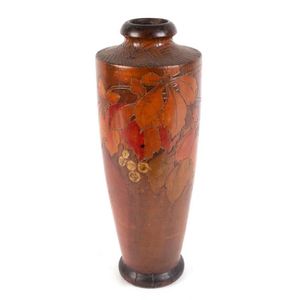Satsuma vase with ho ho bird and prunus blossom
You must be a subscriber, and be logged in to view price and dealer details.
Subscribe Now to view actual auction price for this item
When you subscribe, you have the option of setting the currency in which to display prices to $Au, $US, $NZ or Stg.
- Gilding - Gilding is a method of ornamentation whereby a thin sheet of gold metal is applied to items made of wood, leather, ceramics, glass and silver for decorative purposes.
For furniture including mirrors, the sheet of gold is usually applied over a coating of gesso. Gesso is a mixture of plaster of Paris and gypsum mixed with water and then applied to the carved wooden frames of mirrors and picture frames as a base for applying the gold leaf. After numerous coats of gesso have been applied, allowed to dry and then sanded a coat of "bole", a usually red coloured mixture of clay and glue is brushed on and allowed to dry, after which the gold leaf is applied. Over time parts of the gilding will rub off so the base colour can be seen. In water gilding, this was generally a blue colour, while in oil gilding, the under layer was often yellow. In Victorian times, gilders frequently used red as a pigment beneath the gold leaf.
Metal was often gilded by a process known as fire gilding. Gold mixed with mercury was applied and heated, causing the mercury to evaporate, the long-term effect of which was to kill or disable the craftsman or woman from mercury poisoning. The pursuit of beauty has claimed many victims, not the least of which were the artists who made those pieces so highly sought after today. - Ho Ho Bird - The ho ho bird is a mythological bird of the East, that in appearance is a composite of many birds including the head of a pheasant, the body of a mandarin duck and the tail of a peacock.
It is used as a decorative motif in both European and Eastern furnishings and decorative arts, especially on ceramics and as part of the carved frame of mirrors. - Cartouche - An ornamental panel in the form of of a shield, oval or rectangular scroll with curling edges. It may be carved into the back of a chair or the top of a sideboard, or present on a piece of silver or jewellery, and contain the initials of the original owner, heraldic symbols, or some other inscription, such as the details of a presentation.
In ceramics the term defines the central area of a vase or similar with a decorative border in one of the shapes above, into which a decorative scene or figures have been painted.
This item has been included into following indexes:
- Japanese ceramics, item types - other 2,525
-
Satsuma (Japan), item type
- other items 2,034
- vases 1,376
Visually similar items

A Japanese cloisonne baluster vase, Meiji period, 1868-1912 delicately wire worked in silver and depicting a songbird beneath flowering wisteria, upon a midnight blue black ground, with silver plated rims and deep green to the interior and base, unmarked,

A Japanese cloisonne vase. Showa period, mid 20th century. The baluster vase in bright mid teal with a stylised and wired floral motif in varying shades of teal with amber highlights; with a white metal rim and foot, marked with emblem and characters; as f

Large pokerwork kookaburra vase in the tapered with a curved rim and shape and decorated with a kookaburra perched in a gumtree, height 36 cm

A pokerwork vase with berries and leaves, Tasmanian origin, circa 1930s 45 cm high
